The Lowdown
Presented by See the Elephant Amaro
Welcome to The Lowdown, a regular Paid Subscriber exclusive featuring what (and where) I’ve recently been eating and drinking. I’ve been holed up in my writing bunker finishing the manuscript for my next book and trying to save a little bread, so I haven’t been out on the town as much but still managed to surface some recent highlights worth sharing.
On today’s The Lowdown…
A delicious new Catalonian Vermut
Easter Lunch at Casa BTP
Dante has a solid cheese board
Camparino brings a taste of Milan on MacDougal Street
And more!

Today’s dispatch is brought to you by the generous support of See the Elephant Amaro.
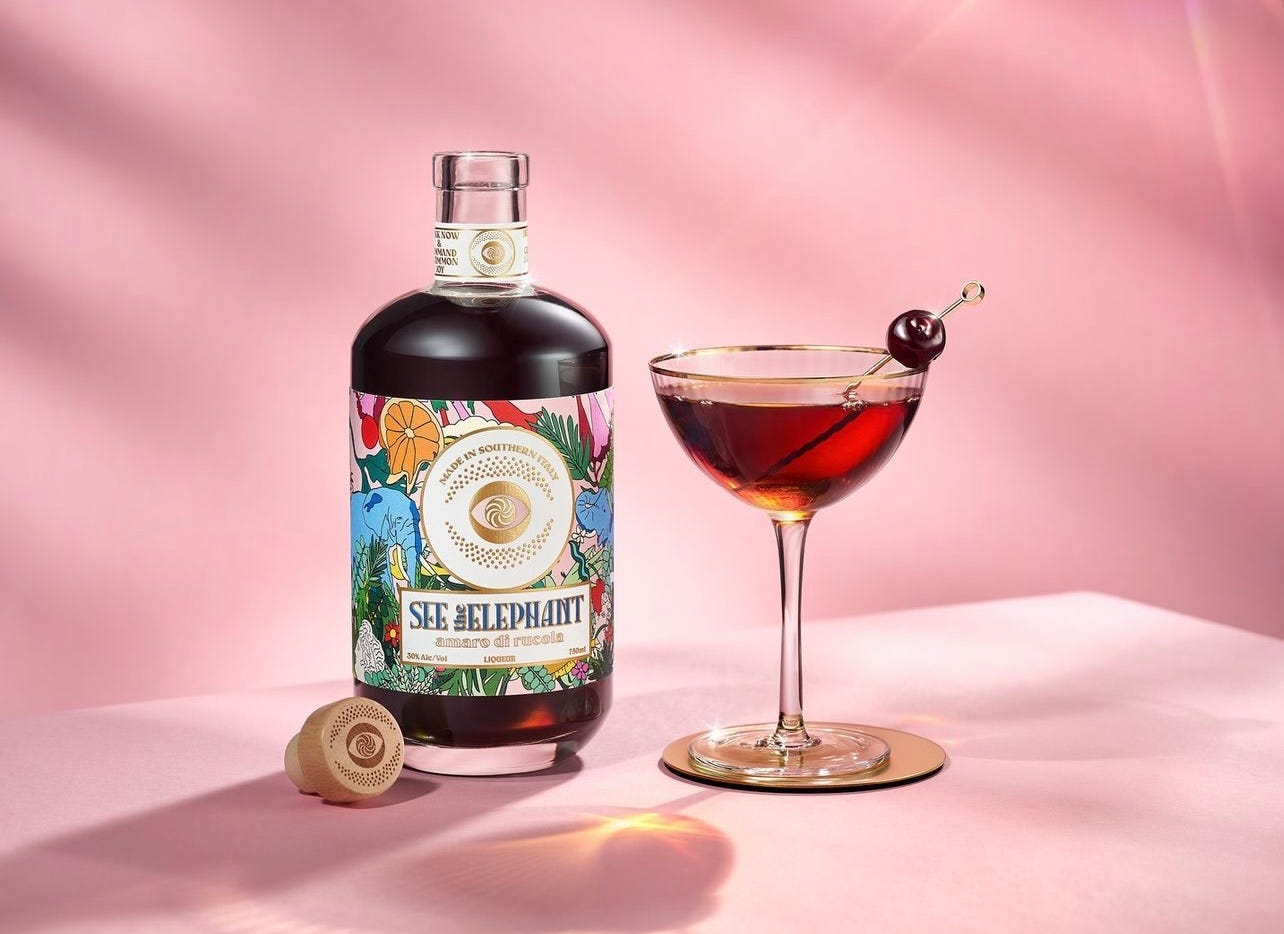
Produced in Agropoli near Salerno, See the Elephant Amaro di Rucola is made using regional herbs and botanicals sourced from the Cilento Coast region of southern Italy—including the signature rucola (“arugula”). One unique characteristic of rucola-style amaro which stands out is the distinctive note of bubblegum (like that the old-school stick of gum that used to be packaged with baseball cards) and See the Elephant Amaro is a best-in-class example of this unique style and an ideal, Italian-born “gateway” amaro for those just starting to explore the world of amaro. Try it neat, over ice, in a Shakerato with mint, or in a creative craft cocktail like the featured The Oleo-phant In the Room from Shaya in New Orleans.
Drink now and command a common joy!
Use Promo Code CIAO to save 10% off or Promo Code DRINKNOW to receive free shipping on 2 more more bottles on online orders from the See the Elephant Shop.
Today’s See the Elephant Amaro “Bartender Series”—where we talk to talented bartenders with a passion for amaro and ask them to share the recipe for their original cocktail spotlighting See the Elephant Amaro—features Ryan Hughes, bartender at Shaya—the acclaimed New Orleans restaurant centered around a wood-fired oven that seamlessly blends classic dishes from North Africa, the Middle East, Eastern Europe, Turkey, and Greece with contemporary Southern flair and innovative culinary techniques—and his cocktail, The Oleo-phant In the Room.
How do you approach using amaro in cocktails?
Ryan: I generally love using amaro as that interesting under-note that you can't always place on the first taste. I find the diverse and versatile aromatics of amaro work so well for an extra depth of flavor.
Do you find that most of your guests at Shaya are quite familiar with amaro these days? How do you help demystify their approach to appreciating amaro?
Ryan: Amaro hasn't seen a high uptick in our day-to-day clientele, although our service-industry folks definitely have it on their radar. I find the best way to demystify it is to encourage getting a cocktail with it as an ingredient, whether that's one of our craft cocktails or simply a classic cocktail, and providing a small sip of the featured amaro right next to it. I love seeing the flash of recognition when the guest creates that bridge between the amaro they just tasted and that hard to place flavor in the cocktail.
Do you have any bartender pro tips when it comes to amaro?
Ryan: I think my biggest piece of advice is to just taste as much amari as you can.
What sets See the Elephant Amaro apart from other amari bottles on the back bar?
Ryan: The interesting shape of the bottle and the absolutely gorgeous design on the label help it visually stand out among the other bottles of amari. Taste wise, I find the almost bubblegum-y sweetness comforting and nostalgic where other amari lean into those bitter and mature notes. I find it a bit more approachable for the newbie to the amaro world.
How do you recommend using See the Elephant Amaro in cocktails?
Ryan: I think the best approach for See the Elephant in cocktails is more as a binder for other disparate flavors one might be trying to get to play well together.
Featured Recipe: The Oleo-phant In the Room
Ryan Hughes, Shaya | New Orleans, Louisiana (2025)

The Oleo-phant In the Room was inspired mostly by my desire to create a light and refreshing whiskey drink to serve during our brutal summer in New Orleans. I landed on grapefruit and ginger for the main flavors but couldn't find a good third element to really kick it up a notch. The two together were pretty flat, though refreshing. Enter Ms. Elephant, brought to the bar by chance by a couple of our brand reps enjoying a relaxing afternoon and talking shop. See the Elephant works so well with the fruitiness of the grapefruit oleo and helps to soften the edge of the ginger, allowing the drinker to only taste the ginger and not necessarily feel that ginger heat. Trust me, you don’t want any additional heat in the summertime! Guest reactions have been very positive overall—glasses only ever come back completely drained!
—Ryan Hughes
Makes 1 Drink
1-1/4 ounce Ginger-Infused Japanese Whisky (recipe below)
3/4 ounce See the Elephant Amaro
1/2 ounce Grapefruit Peel Syrup (recipe below)
1-1/4 ounce freshly squeezed grapefruit juice
Soda water, to top
Garnish: grapefruit peel or candied grapefruit peel and oil of fresh graprefruit peel
Combine all the ingredients in a cocktail shaker filled with ice. Shake until chilled and and strain into a collins glass over ice. Top with a splash of soda and garnish with a grapefruit peel, or candied grapefruit peel and oil of 1 grapefruit peel.
Ginger-Infused Japanese Whisky
Combine 25g peeled and finely grated (preferably microplaned) ginger with 750ml of Japanese Whisky (preferably Suntory Toki). Allow to steep at room temperature for 2 hours, stirring occasionally. Strain back into the empty bottle.
Grapefruit Peel Syrup
Add the peels of 4 whole grapefruit (preferably ruby red grapefruit) to a bowl with Mix with 500g white cane sugar. Muddle to release oils and mix thoroughly. Let sit at room temperature to continue the release of oils for 24 hours. Add 500mL near-boiling water and until sugar is dissolved. Strain peels and discard, or save and dehydrate for garnish.
The Lowdown
Drinking
“La Hora del Vermut” (The Long Island Bar)
110 Atlantic Avenue, Brooklyn, New York 11201

First launched in 2024 by Phi Peinado and David Neimanis, two American friends who both permanently moved to Spain, the new-to-the-U.S.-market Cueva Nueva Vermut Rojo lives up to the spirited tradition of Spanish vermouth but with an eye toward the modern drinker. Made in Tarragona, Catalonia, Spain, Cueva Nueva contains a white-wine base of a blend of Garnacha Blanca and Airén grapes, fortified with a lineup of 88 botanicals including wormwood, orange peel, and cinnamon. While it plays well in cocktails like the Negroni, it’s especially delicious served on its own over ice with a splash of a soda, garnished with an olive and an orange slice.
Neimanis had sent me a bottle a while ago and one recent evening I brought it with me to try before dinner at The Long Island Bar. We drink a lot of vermouth and soda at L.I.B. and I’m well aware of co-owner Toby Cecchini’s discerning tastes when it comes to spirits, but as he had just returned from a trip to Spain I handed over the stylishly understated bottle of Cueva Nueva, complete with a swing-top toggle closer, and in no time we had an impromptu “La Hora del Vermut” right here in Cobble Hill. I really loved the vermouth’s cream soda-like profile and it was a hit with everyone who tried it. I definitely encourage you to seek out a bottle.
Beer & Sake (The Long Island Bar)
110 Atlantic Avenue, Brooklyn, New York 11201

On some Tuesday and Wednesday nights after the buzz of the evening rush at The Long Island Bar has settled into its groove, I’ll often receive a text from co-owner Toby Cecchini inviting me to join him in The Lombardi Room in the back of the bar to watch whatever basketball games might be playing on the large wall-mounted television that’s usually covered by the Wisconsin State flag. We fall into an easy rhythm of watching the game with Cecchini disappearing from time to time to tend to a business matter or say hello to friends and regulars in the front room.
At that point in the night nothing beats beer and sake, and Cecchini will come up from the basement with a 1.8 liter isshobin of Hakurakusei “Junmai Ginjom,” a clean and balanced sake from one of his favorite Japanese brewers located in Miyagi Prefecture. He prefers the Japanese-style rice lager from Other Half Brewing on draft while I usually opt for a Captain Lawrence Brewing Co. Kölsch. A perfect pairing among excellent company. Let’s go Knicks!
Campari Seltz & Improved Shakerato (Accademia Dante)
79-81 MacDougal Street, New York, New York 10012

The recent second installment in the year-long Dante Legends Series welcomed Tommaso Cecca and Simone Gaspari of the historic Camparino in Galleria in Milan (which is always my first stop when I visit Milan) for a four-day residency at Accademia Dante. I first met Tommaso in Milan in 2017 when I was in Italy working with Campari’s Amari Club and since then have collaborated with him here in New York at the Campari Academy and have never missed any of his pop-ups or guest shifts.

This pop-up was sponsored by Mastercard so you needed to be a Mastercard holder registered in their Priceless program, which I am not. But I was invited to attend the Monday media preview which didn’t include the full experience that ticketed guests would enjoy, but I did get to catch up with Tommaso and sample some excellent signature cocktails among the featured drinks on the menu (and even one very strong off-menu Martini). I met a charming publicist from Mastercard who was shocked I didn’t have a Mastercard and insisted we could remedy that, though she may have run a credit-check as I never heard back from her.
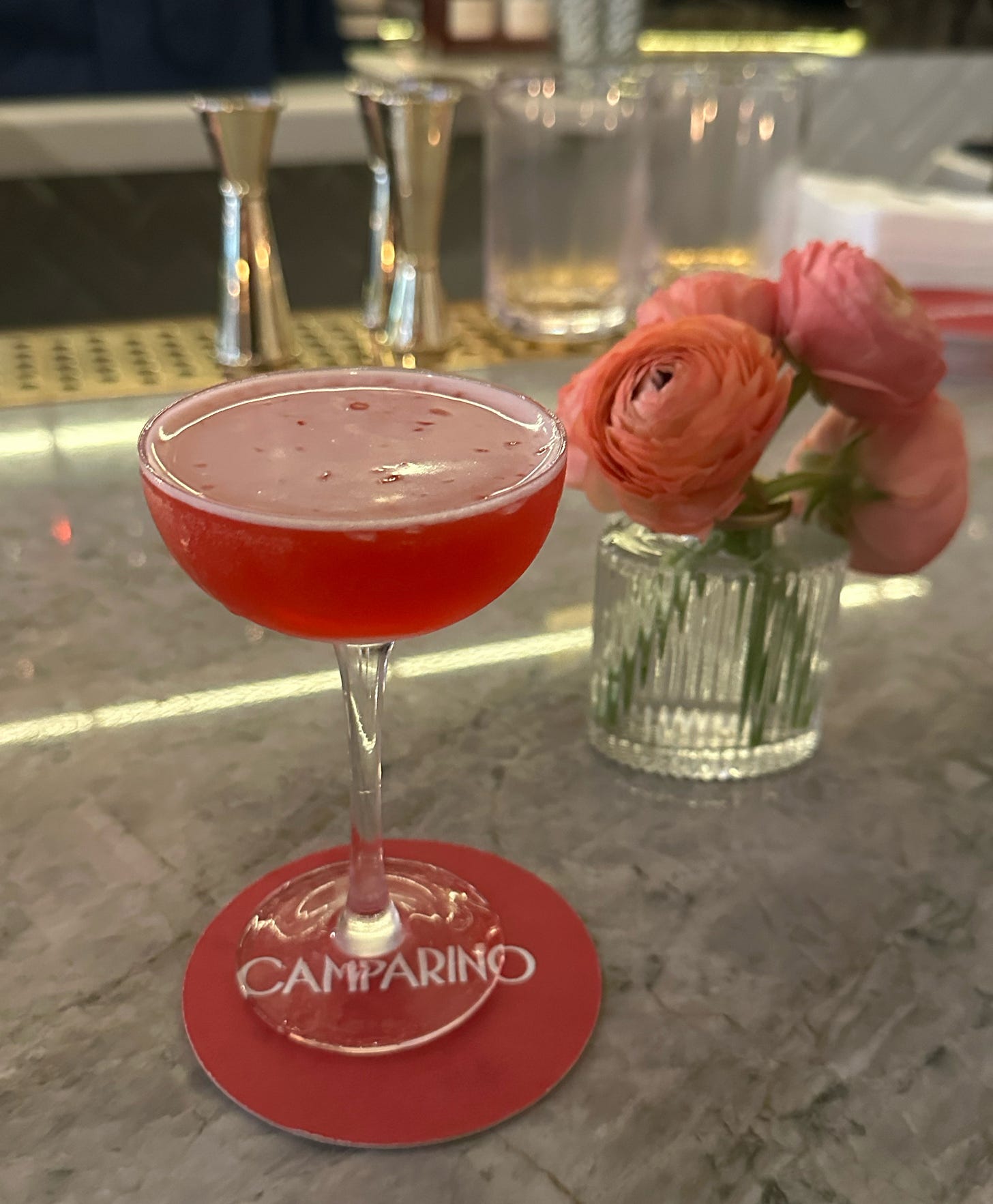
As things always do when it comes to Camparino, I started with their iconic Campari Seltz, the seemingly simple build of Campari and seltzer that achieves full-on more-than-the-sum-of-its-parts status thanks to the drink’s frozen bespoke glass, ice-cold Campari, and burst of cold seltzer that quickly fills the glass, leaving a pinkish layer of foamy bubbles in its wake. At Camparino that blast of bubbles comes courtesy of built-in siphon guns attached to the bar that run down to a custom machine in the basement of the bar, but when on the road, Tommaso packs an oversized soda siphon in his suitcase.
Another standout among the drinks I tried was the Improved Shakerato that included the expected reverse dry-shaken Campari with a burst of added flavor from raspberry, mint, and a bit of Paragon Rue Berry botanical cordial. Salute!
Whiskey Sours, Martinis & Short Beers (Grand Army)
336 State Street, Brooklyn, New York 11217

Last Monday I stopped by Grand Army, selecting the venue as a place to meet up with my friend Michael Oates Palmer (who LAST CALL readers may remember from his recent appearance and excellent playlist on Dive Bar Jukebox) on his last night in the Big City after a weekend of eating and museum-hopping before heading back home to Los Angeles, and to pay my respects to bartender Luis Balbuena, who was working his last shift behind the bar there. He gave me a big hug and I passed along a signed copy of Last Call as a thanks for his service and always excellent hospitality.
Michael Smoley, the US Market Manager for Boatyard Gin came through with Declan Padraic McGurk, the Commercial Director of Boatyard Distillery in North West Ireland, and sat near us at the end of the bar (thanks for the Martinis, gents!). It was one of those nights where there were no photos taken of what we drank (Whiskey Sours, Martinis, Kölsch), just a selfie of the two of us happy and smiling (a rare state for me these days), which serves as proof enough of a good time had by all.
And tune back in to LAST CALL on Tuesday, April 29th for an exclusive first look and reveal of the next theme along with a breakdown of each and every cocktail featured on the new Grand Army Spring/Summer 2025 Menu going live on Wednesday, April 30th.
Eating
Cheese Board (Caffe Dante)
79-81 MacDougal Street, New York, New York 10012

When of my favorite “nibbles” to order when I’m feeling peckish on a late Friday afternoon at Caffe Dante is their excellent Cheese Board. You can opt for 1 piece, 3 pieces, or the full board and I find that, like olives in a Martini, three is the magic number. I think the one pictured above had the sleeper hit hunk of Aged Gouda, a funky leveled pillar of Gorgonzola Piccante, and a super-creamy La Tur. But it’s those salty (Marcona almonds), sticky (honeycomb), crunchy (fig & grape crackers), and crisp (Anjou pear) accompaniments that takes things to the next level.
Sausage, Egg & Cheese Sandwich (Daily Provisions)
151 Court Street, Brooklyn, New York 11201
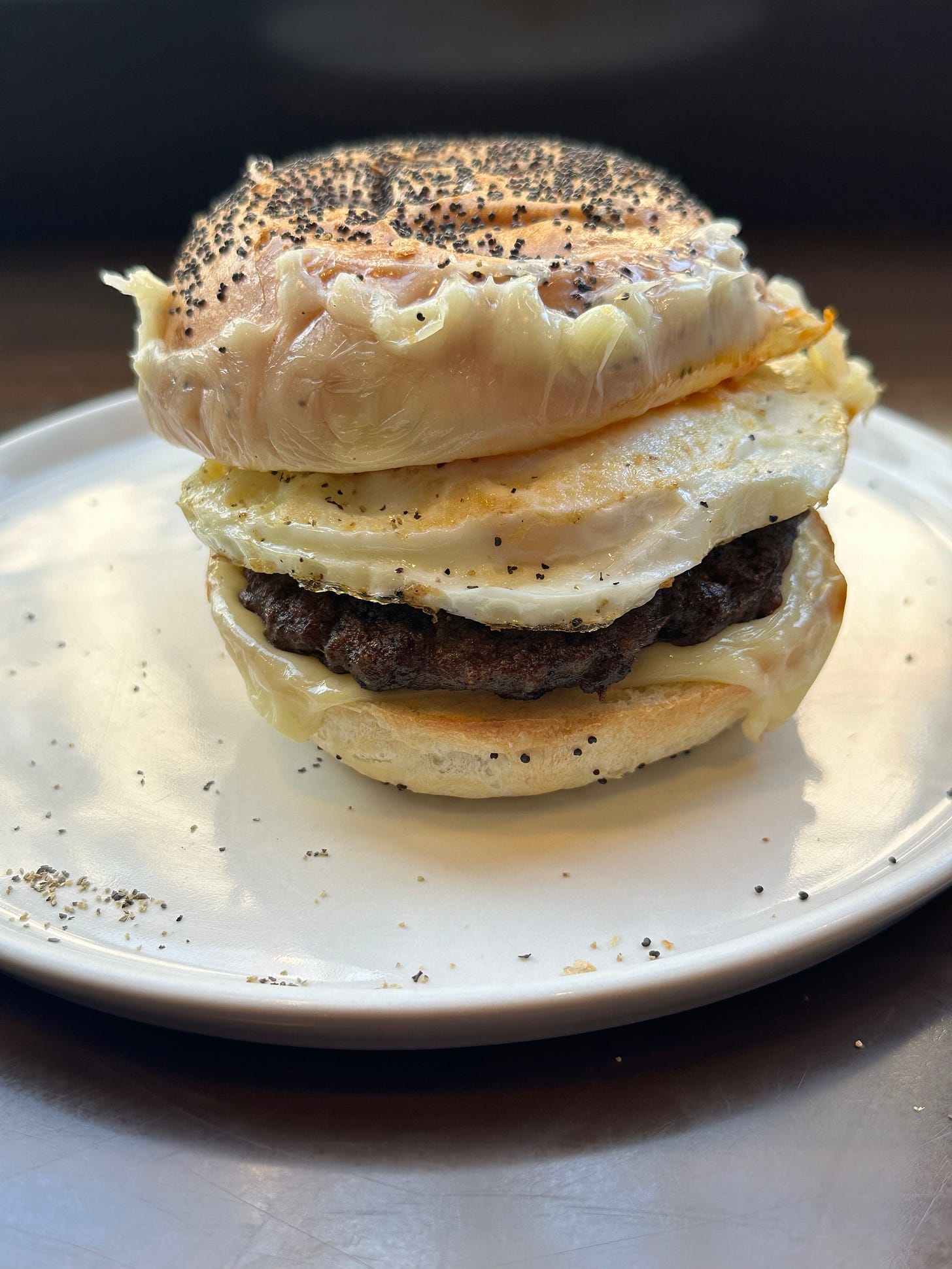
Everyone loves the OG Berkshire Bacon, Egg & Cheese Sandwich at Daily Provisions, but wise ones know it’s all about the Sausage, Egg & Cheese. My local DP in Cobble Hill is always packed, especially with annoying laptop squatters and the stroller set nursing a single cup of coffee while claiming every seat. When I was in recently on a busy Saturday patiently waiting to order, I had my eyes set on two empty stools at the counter but the self-entitled woman behind me sent her child over to secure those prime seats on their behalf. I just exhaled, shook my head, and muttered to myself like my father used to in such situations.
All the outdoor tables were packed and my favorite benches served as a pit-stop for the delivery guys and their bulky e-bikes. After moving a vacant stroller I found the last available seat over by the dish-pit, but the sandwich—with a patty of seasoned pork sausage, a runny fried egg (which always, every single time, squirts its bright yellow yolk onto my shirt), and American cheese—quickly changed my sour mood. Always ask for a side of their signature Wake-Up Sauce to lightly dress the interior of the sandwich for a spicy and tangy bit of heat.
Plain Slice (The House of Pizza & Calzone)
132 Union Street, Brooklyn, New York 11231

I miss living two doors down from The House of Pizza & Calzone on Union Street, but I still try to stop by once a week to get my slice fix (usually after swinging by Mazzola’s). Everyone has their favorite plain slice spot in the Big City and THOPC is mine. Normally I’d have a can of DC but they’re beholden to Pepsi products so I usually grab a Diet Dr. Brown’s Cream Soda. When it comes to the assortment of seasonings lined up next to the paper napkin dispenser, I always give it a little sprinkle of salt and pepper. Boom.
Easter Lunch (Casa BTP)
Brooklyn Heights, Brooklyn
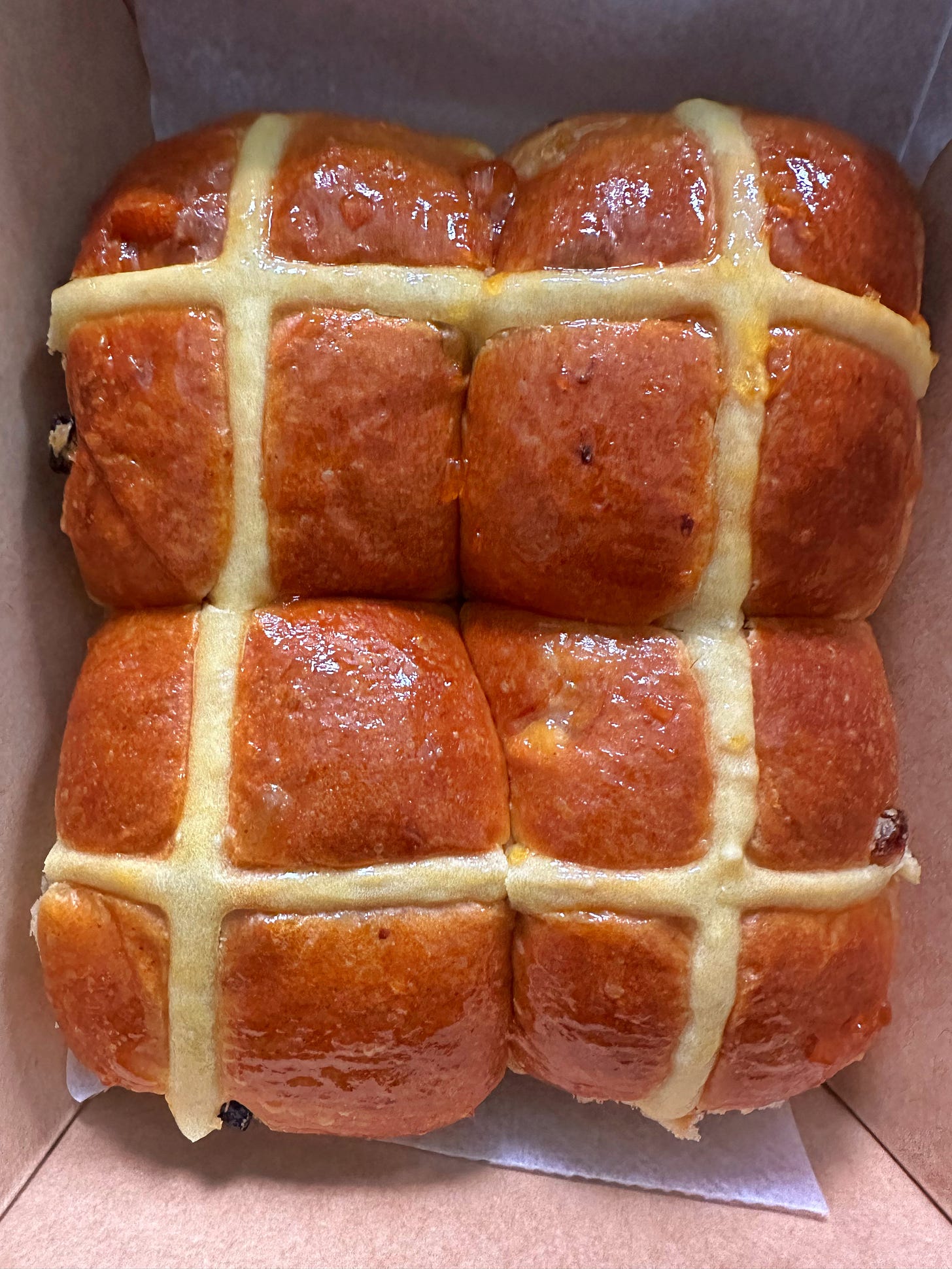
Easter Sunday marked the first time undertaking a more involved meal prep with my new, and very curious, roommate Enzo in the apartment. But I managed to make it through without incident timing the prep and cooking to the 3-4 hour window in the afternoon where he disappears under my bed for a earned cat nap.
My Instagram feed was peppered with pre-order promotions from local bakeries for their hot-cross buns. Laurel Bakery near me had a large-format pull-apart HXB situation with a tropical twist with the addition of a mango glaze along with a side tub of salted butter. My favorite Ciao, Gloria was also promoting some nice-looking HXBs but had a 6-count pre-order minimum. Once the holiday weekend commenced I figured I’d swing by Caputo’s as I recalled getting some there in years’ past, but on Saturday morning I stoped by Ciao, Gloria (which is always packed at that time with members of a local running club stopping in after finishing their route, lending a gamey post-run funk mingling with the smell of fresh coffee and cinnamon buns) and I was in luck as they had a whole tray of HXBs on display. I picked up four but ended up only eating two of them (believe it or not, my eyes are always bigger than my stomach). I had them for breakfast the name day, split open with a swath of salted Irish butter. Like Soda Bread on St. Patrick’s Day, I think Hot Cross Buns are more about the idea and tradition rather than any burning desire, but I was happy to have them as part of my Easter.
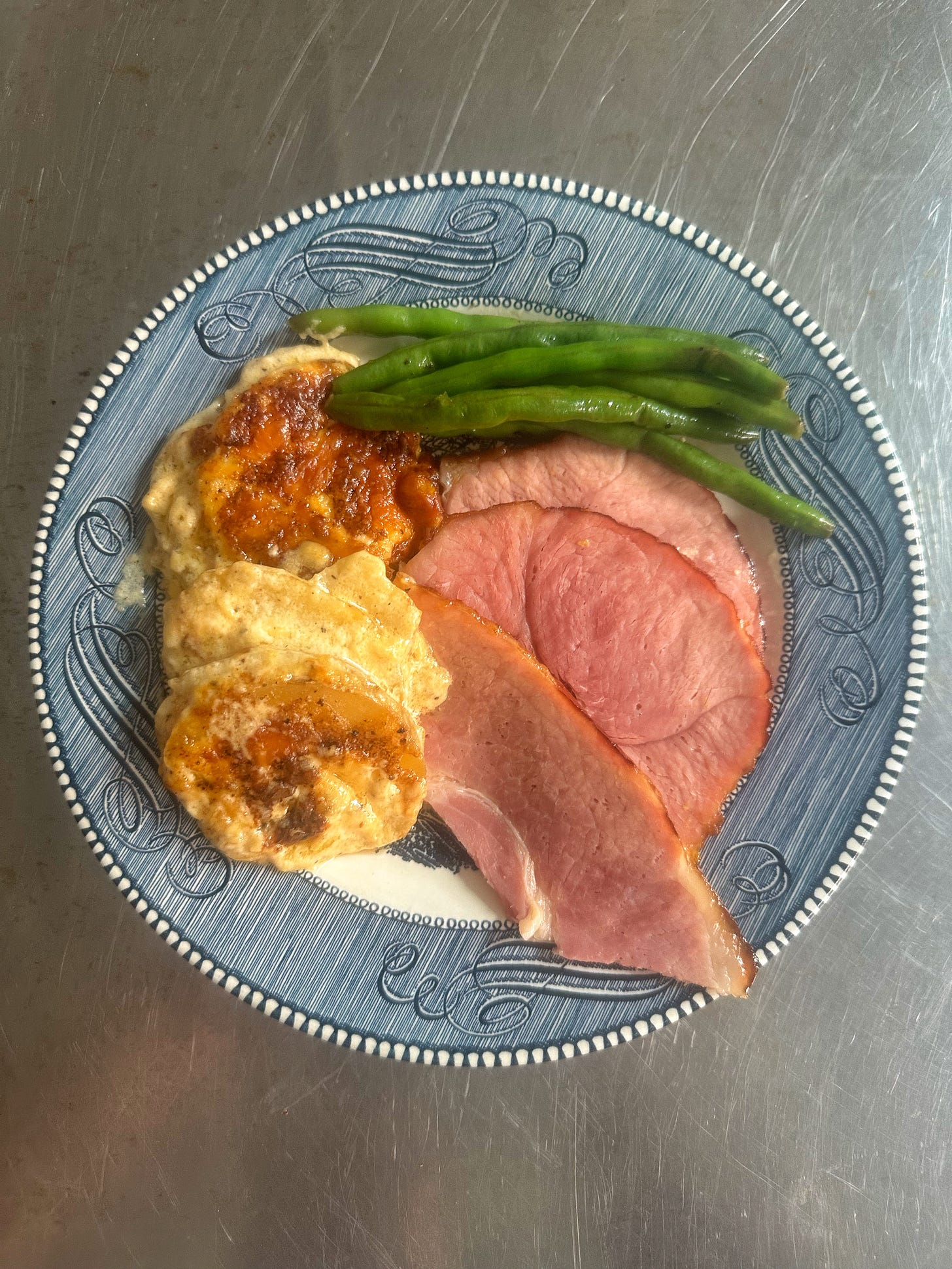
With leftovers in mind, I always make a ham for Easter (and have one on hand for Christmas as well). This was the first time I ever prepared a spiral-cut ham. I’ve had plenty of these at holiday parties but they had a reputation of running dry and being too thin compared to hand-carving half of a bone-in ham. And I admit while I’ve had plenty of ham carving experience, it’s always a bit of a circus navigating the fat and muscle lines with each section usually achieving a different level of doneness. But this spiral-cut number did the trick and made carving a breeze. I painted it with a makeshift glaze with Dr. Pepper, brown sugar, mustard, and a splash of apple cider vinegar and pretty much had ham and potatoes au gratin for dinner all week, skipping dinner each night from such hearty daytime fare. I picked up a slice of Carrot Cake Cheesecake from Mia’s on Smith Street but only could handle a couple of bites. I’ve promised myself from now on all holiday desserts will be a Carvel Fudgie the Whale ice cream cake no matter the occasion because Fudgie don’t front.
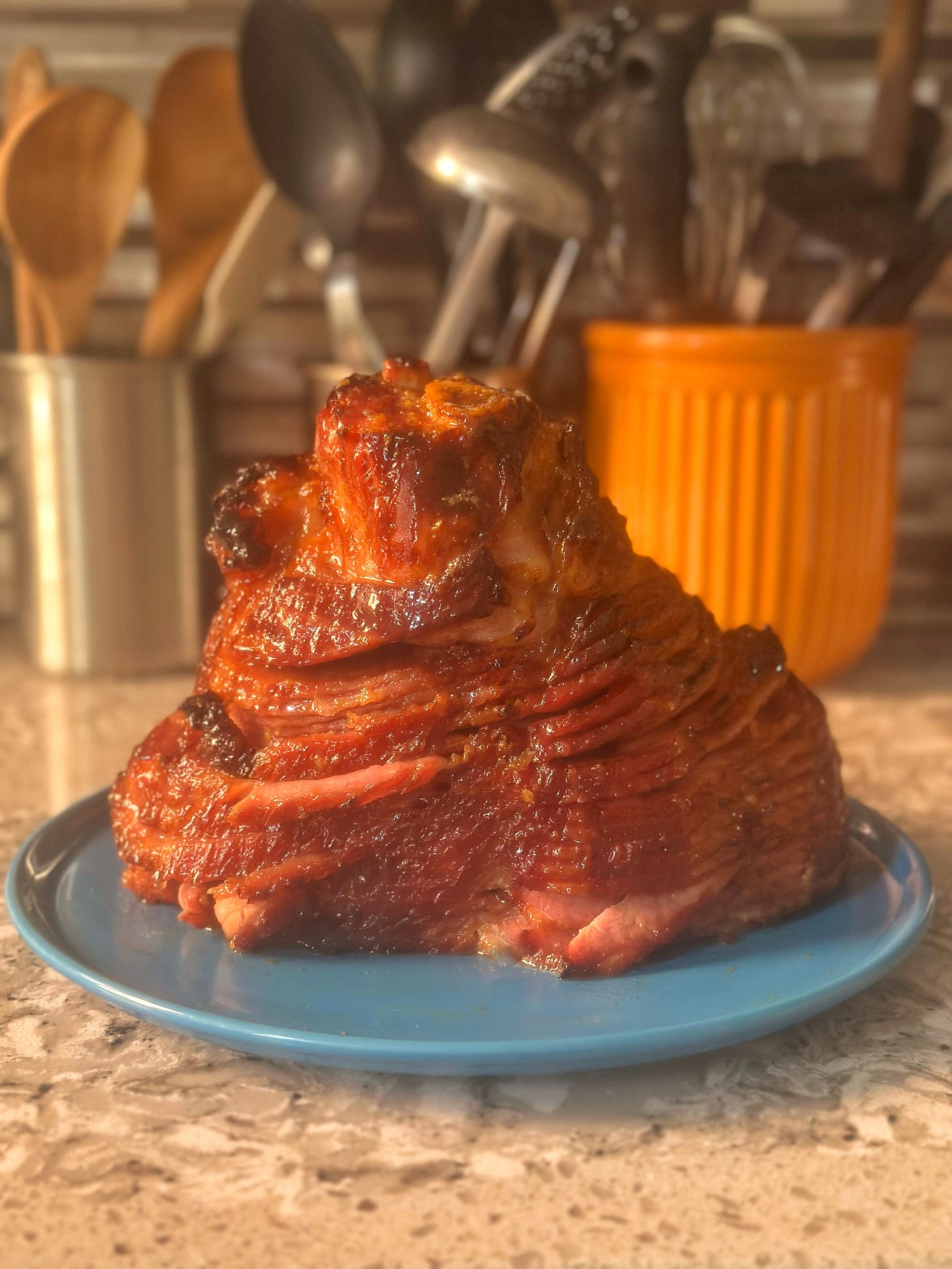
Our thanks to See the Elephant Amaro for underwriting today’s LAST CALL dispatch.

Use Promo Code CIAO to save 10% off or Promo Code DRINKNOW to receive free shipping on 2 more more bottles on online orders from the See the Elephant Shop.
If you are a brand or business in the beverage, food, or lifestyle space interested in learning more about sponsorship opportunities on LAST CALL, please contact us for more details.
Follow Brad Thomas Parsons on Instagram.
Links to some featured products are shared via affiliate programs.
LAST CALL logo and design by Ed Anderson.



Your Easter lunch looked glorious….brava!
This segment of low down made me thirsty and hungry. Ha, well done!